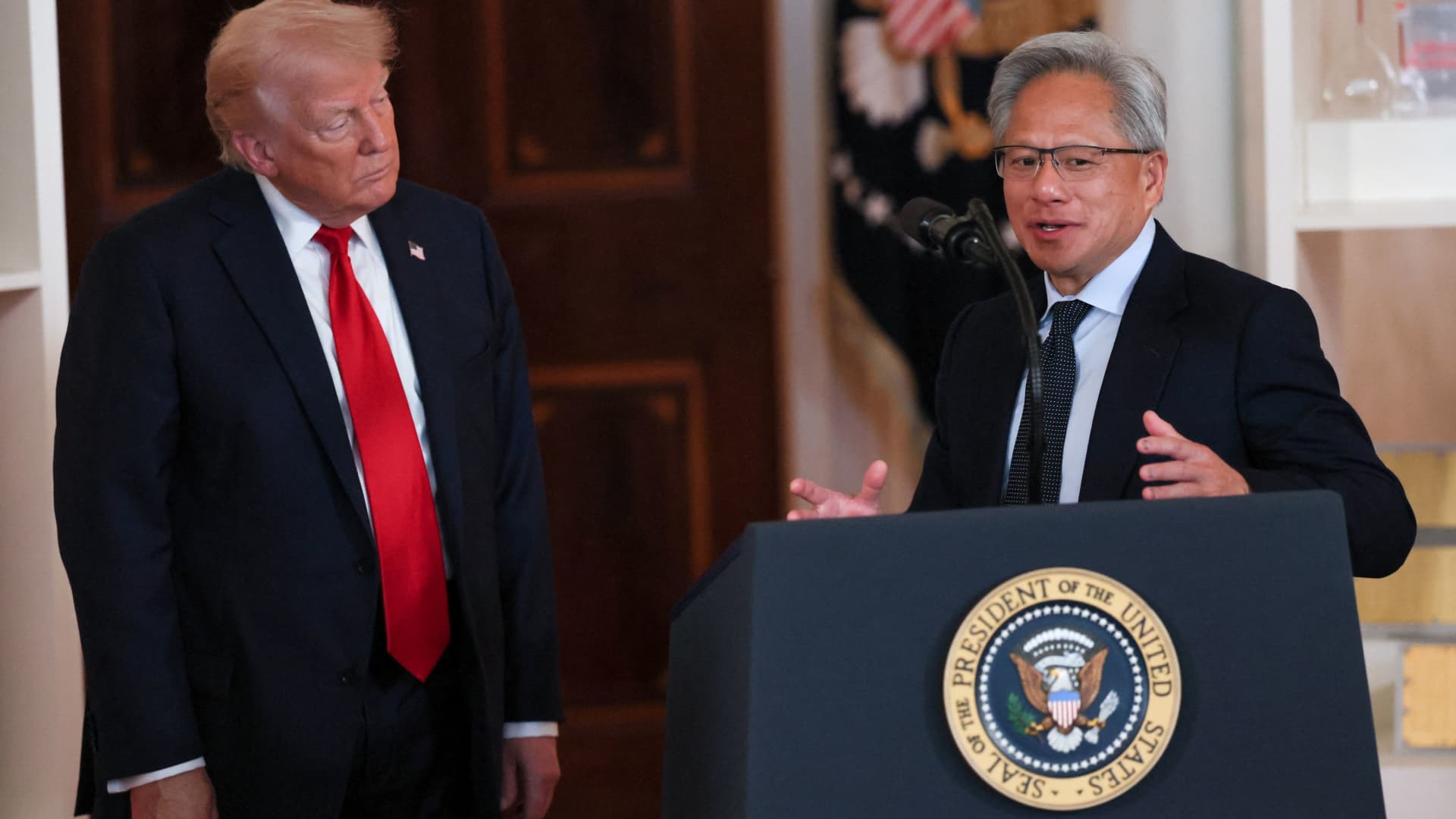Nvidia, a global leader in graphics processing units (GPUs) and artificial intelligence (AI) technologies, stands at a critical juncture. The company’s CEO, Jensen Huang, recently met with former President Donald Trump at the White House, just before a scheduled trip to China. This meeting occurred as Nvidia briefly achieved a $4 trillion market capitalization, a milestone unmatched by any other company. The convergence of these events raises important questions about Nvidia’s strategic positioning, the geopolitical dynamics shaping the tech industry, and the future of AI-driven innovation.
A Strategic Meeting: Nvidia and the White House
The meeting between Jensen Huang and Donald Trump carries significant implications. While the specifics of their discussion remain undisclosed, the broader context provides valuable insights. Trump’s well-documented focus on domestic manufacturing and technological leadership aligns with Nvidia’s substantial investments in U.S.-based chip production. Huang has publicly emphasized Nvidia’s commitment to manufacturing the most advanced AI chips in the United States, a pledge that likely resonates with Trump’s priorities.
The timing of the meeting is also noteworthy, as it coincides with ongoing trade tensions and concerns about China’s technological advancements. Nvidia’s advanced chips are essential for AI development, and the U.S. government has been closely monitoring the export of such technology to China. The meeting may have served as a platform to discuss export controls, tariff threats, and the delicate balance between fostering innovation and safeguarding national security.
Trump’s history of protectionist trade policies, including his interest in imposing tariffs on semiconductors, adds another layer of complexity. Huang likely sought to understand Trump’s stance on these issues and to advocate for policies that support Nvidia’s global operations while ensuring U.S. technological leadership. The meeting underscores the intricate relationship between corporate strategy and geopolitical considerations in the tech industry.
Balancing Act: Nvidia’s Engagement with China
Huang’s impending trip to China further complicates the situation. China represents a massive market for Nvidia, and the company has been navigating U.S. export restrictions while catering to Chinese demand. The development of the H20 AI chip, designed to comply with U.S. regulations for sale in China, exemplifies Nvidia’s balancing act.
The proximity of Trump’s meeting with Huang to the CEO’s scheduled departure to China suggests a coordinated effort to align Nvidia’s engagements in China with U.S. strategic interests. Huang’s visit to China is likely aimed at strengthening relationships with Chinese partners and exploring further collaboration opportunities. However, he must navigate political sensitivities and potential risks, including intellectual property concerns, regulatory uncertainties, and competition from domestic Chinese chipmakers.
China’s leadership in AI adoption and deployment makes it a critical market for Nvidia’s AI-related products and services. The Chinese government’s significant investments in AI research and development, coupled with its ambitious AI initiatives, present both opportunities and challenges for Nvidia. The company must strike a delicate balance between leveraging the Chinese market’s potential and mitigating the risks associated with operating in a geopolitically sensitive environment.
The $4 Trillion Milestone: A Testament to Nvidia’s Vision
Nvidia’s brief achievement of a $4 trillion market capitalization is a remarkable accomplishment, solidifying its position as a dominant force in the tech industry. This milestone reflects not only short-term market sentiment but also Nvidia’s long-term vision and successful execution of that vision.
Nvidia has positioned itself at the forefront of several key technology trends, particularly artificial intelligence. Its GPUs are the industry standard for AI training and inference, and its software platforms, such as CUDA, have become essential tools for AI developers. The demand for Nvidia’s products is driven by the explosive growth of AI across various industries, including cloud computing, autonomous vehicles, healthcare, and finance.
Beyond gaming, Nvidia has diversified its business into data centers, automotive, and professional visualization. This diversification has made the company less reliant on any single market and has strengthened its overall resilience. Analysts predict continued growth for Nvidia, citing the ongoing AI boom and the company’s strong competitive position. Some even suggest that Nvidia could be among the first companies to reach a $5 trillion or even $10 trillion market cap in the coming years.
Navigating the Future: Challenges and Opportunities
Despite its impressive success, Nvidia faces several challenges. Competition is intensifying, with companies like AMD, Intel, and numerous startups vying for a piece of the AI chip market. Geopolitical tensions could disrupt Nvidia’s supply chain or limit its access to key markets. Rapid technological advancements could render its current products obsolete if it fails to innovate.
However, Nvidia also has significant opportunities. The demand for AI chips is expected to continue growing rapidly for years to come. Nvidia is investing heavily in research and development to stay ahead of the curve. Its strong brand reputation and established customer relationships give it a significant advantage over its competitors.
The AI revolution presents both immense opportunities and significant challenges. It has the potential to improve productivity, create new jobs, and solve some of the world’s most pressing problems. However, it also raises concerns about job displacement, bias in algorithms, and the ethical implications of AI-powered weapons and surveillance systems. Nvidia’s role as a key enabler of AI technology will only become more critical as these challenges and opportunities unfold.
Conclusion: A Pivotal Moment for Nvidia and the World
Nvidia’s Jensen Huang meeting with Donald Trump before embarking on a trip to China, all while the company’s market cap flirts with the $4 trillion mark, represents a pivotal moment. It highlights the complex interplay between technology, geopolitics, and economics in the 21st century. Nvidia’s success is not only a testament to its technological prowess but also a reflection of its ability to navigate the ever-changing global landscape. As Nvidia continues to push the boundaries of AI and shape the future of technology, its actions will have far-reaching consequences for businesses, governments, and individuals around the world. The stakes are high, and the world is watching.











